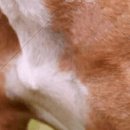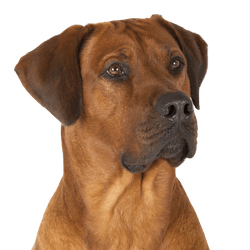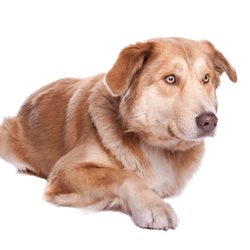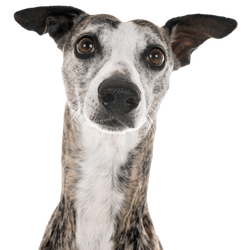
English pointer Breed description: Character & Co
English pointer
Facts & Origin
Ancestry and origin of the English Pointer
The English Pointer (short Pointer) is a British hunting dog. Its ancestors come from Spain and France. British soldiers brought it to Great Britain. From the crossing with Foxhounds, Greyhounds and French running dogs the today's race developed. The Pointer is among the classic pointing dogs, e.g. German Wirehaired, Weimaraner, French Pointing Dog, Small Munsterlander, Irish Red Setter and others, the hunting dog with the most pronounced pointing characteristic. It points with his whole body, front paw, neck and nose to the exact spot where the game is hiding. From this behavior also comes his English name "Pointer".




| Alternate Name | Pointer |
| Origin | UK |
| Life expectancy | 10 - 14 years |
| Care requirements | low-maintenance |
| Activity level | high |
| FCI group | British and Irish Pointers and Setters |
| AKC group | Sporting Group |
| KC group | Gundog Group |
English pointer mixes
Attitude, character and temperament of the breed
Breed characteristics of the English Pointer and temperament
The distinctive hunting passion of the Pointer is in the first place. It is the thoroughbred among the hunting dogs. The character traits of the gentle dogs can be described as follows:
- clever
- friendly
- sensitive
- obedient
- willing to learn
English Pointers have an overall amiable, even temperament and are extremely loyal and devoted to their owners. They are obedient but not submissive.
Attitude and upbringing
The English Pointer is first and foremost a hunting dog. In order for it to live out this innate passion, it belongs best in the hands of a hunter. The hunting instinct of the dogs can, although not be weaned off, but brought under control to a certain extent. Therefore also non-hunters can hold it well. Then, however, the movement-joyful dogs must be sufficiently occupied. Daily exercise, preferably jogging, cycling or horseback riding or alternatively long walks through nature are a must, otherwise there is a risk of behavioral disorders. If kept appropriately, however, it is a good companion and family dog. Friendly to family members but wary of strangers. Dog training should be gentle and sensitive but consistent. A dog school can help with this.
Character
Usage



Health and breeding information
Care and nutrition
It is sufficient to brush the short coat of the English Pointer twice a week. That is already half the care. In addition, the floppy ears should be checked regularly and cleaned if necessary to prevent inflammation. That's it. For a healthy diet, a protein-rich animal food is suitable, in which meat is the main ingredient. Food that contains grain is to be avoided. The feeding of the dogs should be divided into two rations per day. After each feeding, it is essential to ensure sufficient rest to avoid life-threatening gastritis, which these very active dogs are prone to. Dry chews for in between and sufficient drinking water complete the diet.
Health and life expectancy
Breed-typical diseases are the acral mutilation syndrome and the hip dysplasia. Both diseases can be avoided by appropriate breeding selection. The robust dogs can then easily reach an age of 14 years.
Worth knowing
If you are interested in the breed and are looking for a serious English Pointer breeder, it is best to visit the homepage of the German Pointer Club or the homepage of the Association for Pointers and Setters. Here you will find a lot of useful information about the popular hunting dog breed and you are guaranteed to find your English Pointer puppy.


Breed characteristics and appearance
The English Pointer is a British dog breed recognized by the FCI and is listed in the FCI systematics in the FCI group 7 (Pointing Dogs), section 2.1 (Pointer), standard no. 1, with working test. The males have a withers height of 63-69 cm, the bitches are somewhat smaller with 61-66 cm. The average body weight of the dogs is between 25-30 kg. The dense coat is short-haired, decidedly smooth and glossy. Numerous colors are permitted in breeding, including solid and tricolored specimens. Whereby the English Pointer colors lemon with white, orange with white, liver brown and white or black and white occur most frequently.
| Fur length | short |
| Fur | flat coated |
| Ear shape | Floppy Ear |
| Tail | lang |
| Anatomy | slim, sporty |
| Size ♀ | 53 - 66 cm |
| Weight ♀ | 16 - 30 kg |
| Size ♂ | 56 - 70 cm |
| Weight ♂ | 18 - 34 kg |
| Suitable For | - |
Colors









Known Diseases
Eye diseases
Often occur with allergies and intolerances.
Hip dysplasia (HD)
The hip dysplasia or hip joint dysplasia of the dog (HD) is a maldevelopment of the hip joint.
Nervous disorders
Nervous disorders are manifested, for example, by disturbances in perception, neurological abnormalities such as tremors, apathy, convulsions, paralysis, tilting of the head, uncontrolled urination and defecation, and behavioural abnormalities.
Sources and relevant links
Offizielle Seite des FCI
Accessed on 02.01.2023
VDH
Accessed on 04.01.2023
Pointer und Setter e.V.
Accessed on 04.01.2023
Gabriele Lehari (2004). Ulmers Großes Lexikon der Hunderassen. Ulmer.
Horst Hegewald-Kawich (2015). Hunderassen von A bis Z: Über 200 beliebte Rassen aus aller Welt. Gräfe und Unzer Verlag.
Other large dogs
Useful Articles

You can find articles that might interest you in the dogbible blog to match your favorite breed.
Visit our magazineto stay up to date on dog trends.
To find out more, view our Privacy Policy
Find here the breed that suits you and find out what character traits it has. Here you can also learn more about the origin, size and weight of your favorite breeds.
Matching your favorite breed, you'll find articles that might interest you on the dogbible dog blog.
Winter hiking with your dog - these 5 tips will help you work as a team
First aid for dogs - everything you should know
Cooking dog food yourself - advantages and disadvantages
Dog beach Balaton: These dog places at the Balaton you should know























